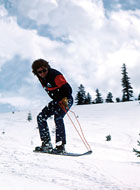alumni profile
King of the Mountain
Jake Burton Carpenter / WSuC '77
by Christian DeBenedetti
If any doubts lingered that snowboarding had progressed from fringe sport to center stage, they were erased during last year’s XX Olympic Winter Games in Torino, Italy. There, before crowds of 10,000 per day, American snowboarders dominated the events, and standing at the finish line to relish it all was Jake Burton Carpenter, one of the sport's progenitors. He had good reason to smile: The entire U.S. team—including then-19-year-old gold medalist Shaun White—was outfitted head to toe in white pin-striped uniforms made by his Vermont-based company, Burton Snowboards, which controls an estimated 40 to 50 percent of the $400 million snowboarding industry.
SNOWBOARD MOGUL BURTON, WHO'S BOARDED ON EVERY
CONTINENT BUT ANTARCTICA, LITERALLY SITS ON TOP OF THE
WORLD DURING A RECENT TRIP TO THE CANADIAN ROCKIES.
It's been a wild ride steering such an iconic brand, but Burton still operates with the laid-back attitude considered typical of the sport. A former competitive skier, he started out at the University of Colorado at Boulder before transferring to study economics at NYU. While there, he interned for a New York hedge fund manager who spurred him to think about launching a snowboard business—and even threw in some early financial assistance. Burton moved to Londonderry, Vermont, after graduation and started experimenting in the back of a barn with a Snurfer, a snowboard-like toy with a rope attached to the nose for maneuvering. "I jigsawed it, I urethaned it," says Burton of his pointy, bindingless fiberglass 1977 prototype. "The quality was good." And despite not selling any in the first year, he had moved more than 700 by 1979, when one of his boards was used to win the World Snurfing Championship, bringing instant exposure and credibility.
By the mid-1980s, snowboarding had become a bona fide countercultural phenomenon, fueled by the bad-boy image of many early riders. But Burton still faced obstacles as the sport exploded in popularity around the country, rankling the ski world. "The people who had been ski bums when they were kids wouldn't accept it, didn't want this youth culture back on their mountains," Burton explains. "The process of getting snowboarding into resorts was really tough, and there's still four that don't even allow it." Still, the eventual success—by 2002, there were more than seven million riders in the United States—continues to surprise the Long Island native. "I never saw it hitting the mainstream," he admits. "It was always an alternative."
Today, Burton snowboards a dependable 100 days a year and shares this love with his employees, giving them season passes to the resort at Stowe Mountain. He constantly tests new gear, and recently managed to take off an entire year with his wife and three boys to travel the globe, snowboarding and surfing. "I was just up in the Canadian Rockies with friends," he recalls, "and I was thinking, 'It just doesn't get any better.' But none of this would have happened if I wasn't really in love with the sport."
Photo above © Jeff Curtes; Photo left © 2007 Burton Snowboards
Burton Snowboards controls an estimated 40 to 50 percent of the $400 million snowboarding industry.

AFTER PLAYING WITH
A SNURFER IN COLLEGE,
BURTON ADAPTED THE EARLY
SNOWBOARD- LIKE TOY FOR
HIS FIRST PROTOTYPE.







